Bài giảng Xử lý tín hiệu số - Introduction - Hà Hoàng Kha
Signal and Systems
A signal is defined as any physical quantity that varies with time,
space or an other independent ariables , or any other independent variables.
Speech, image, video and electrocardiogram signals are information-bearing
signals.
Mathematically, we describe a signal as a function of one or more
independent variables.
Examples: x( ) 110sin(2 t = π ⋅50 ) t
I x y ( , ) 3 = x + 2xy +10y2
A system is defined as a physical device that performs any operation
on a signal.
A filter is used to reduce noise and interference corrupting a desired
information-bearing signa
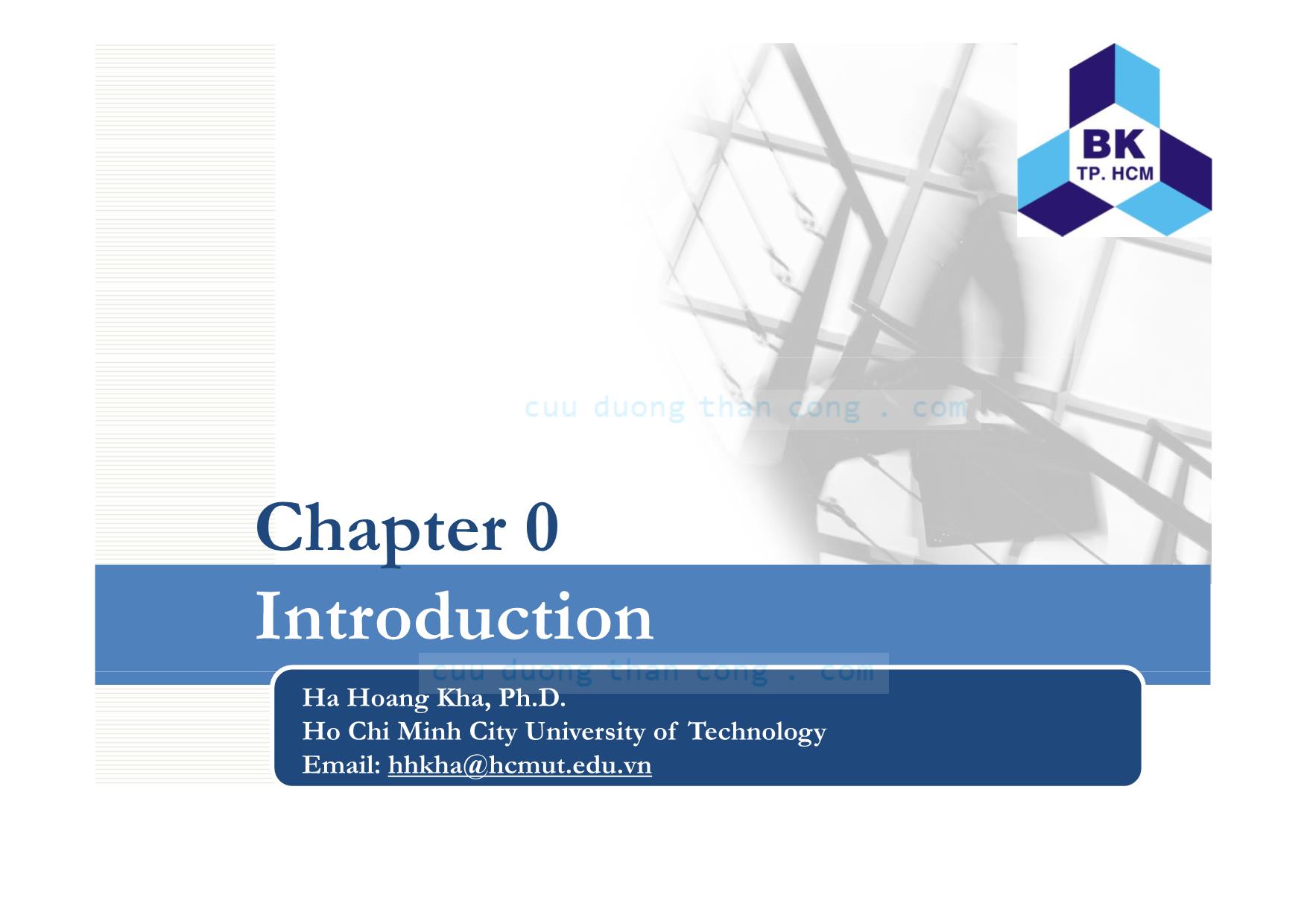
Trang 1
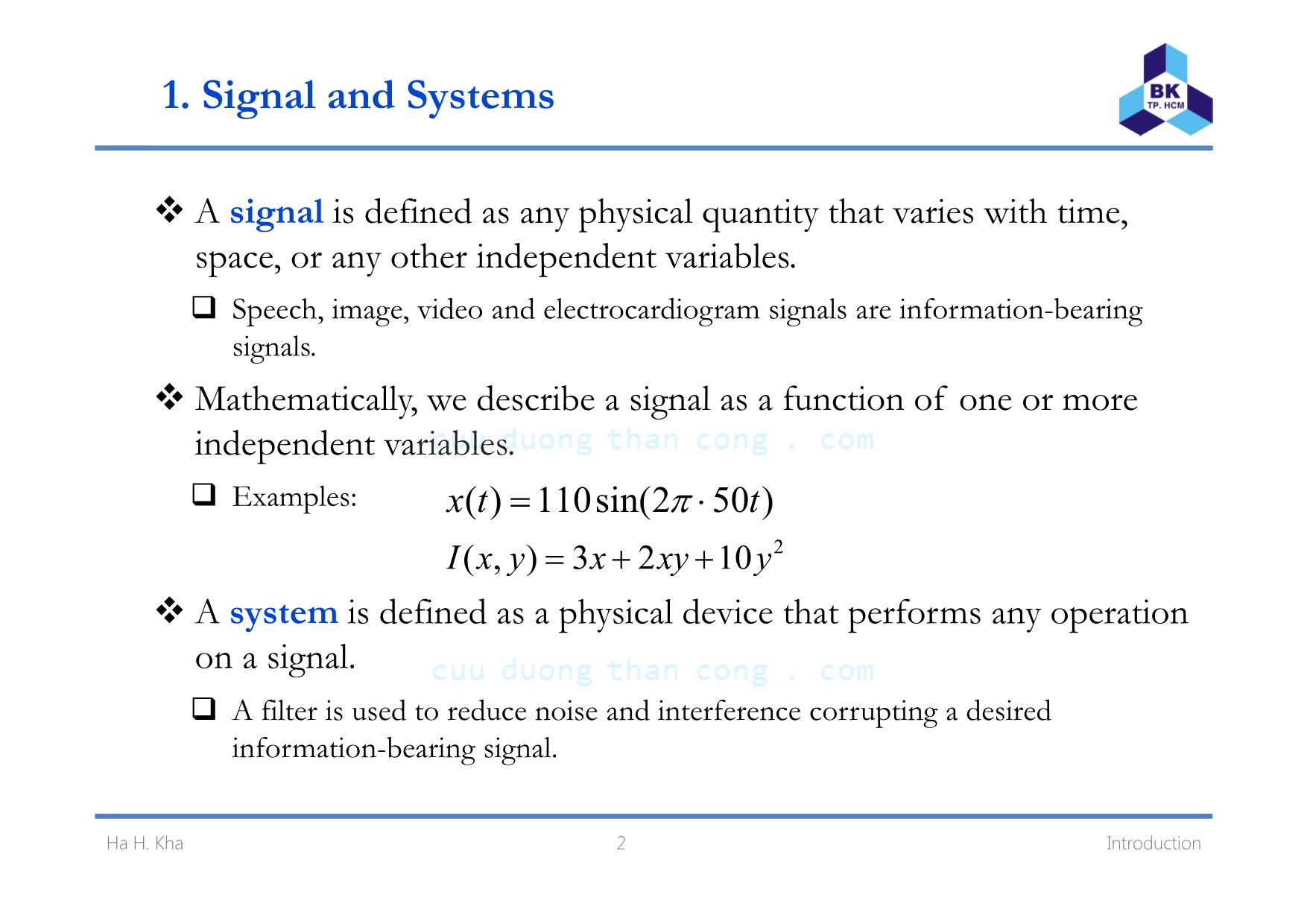
Trang 2
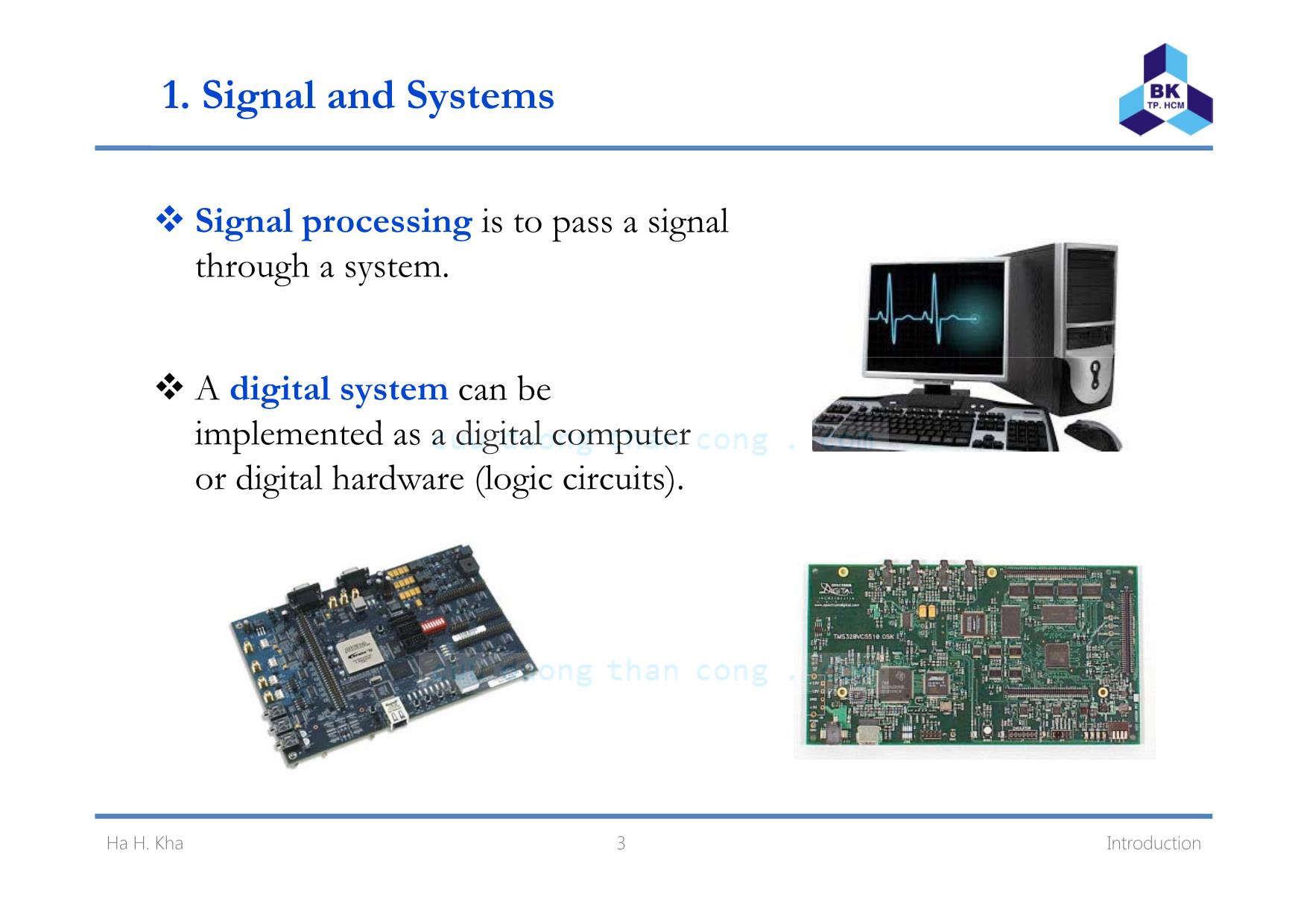
Trang 3
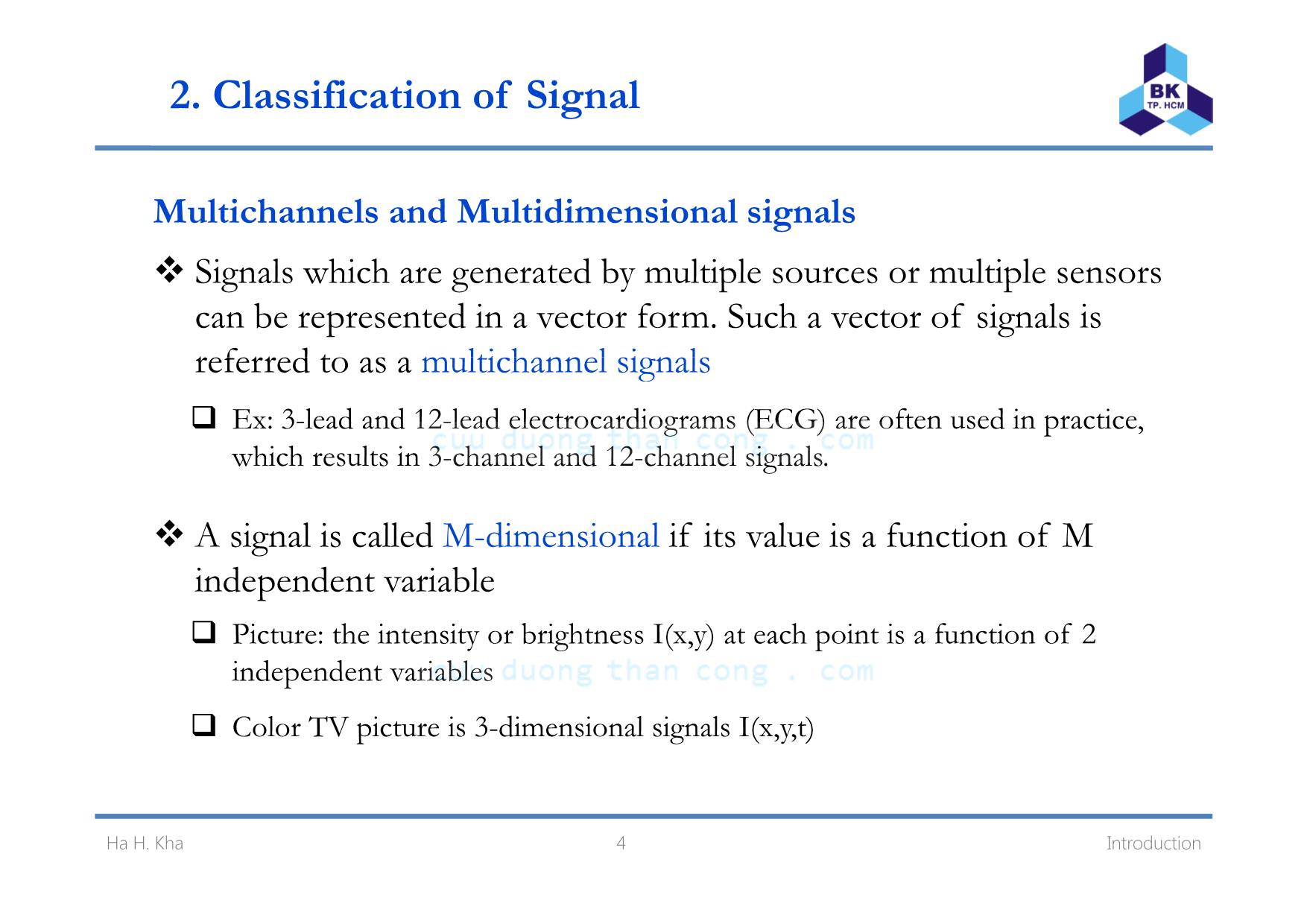
Trang 4
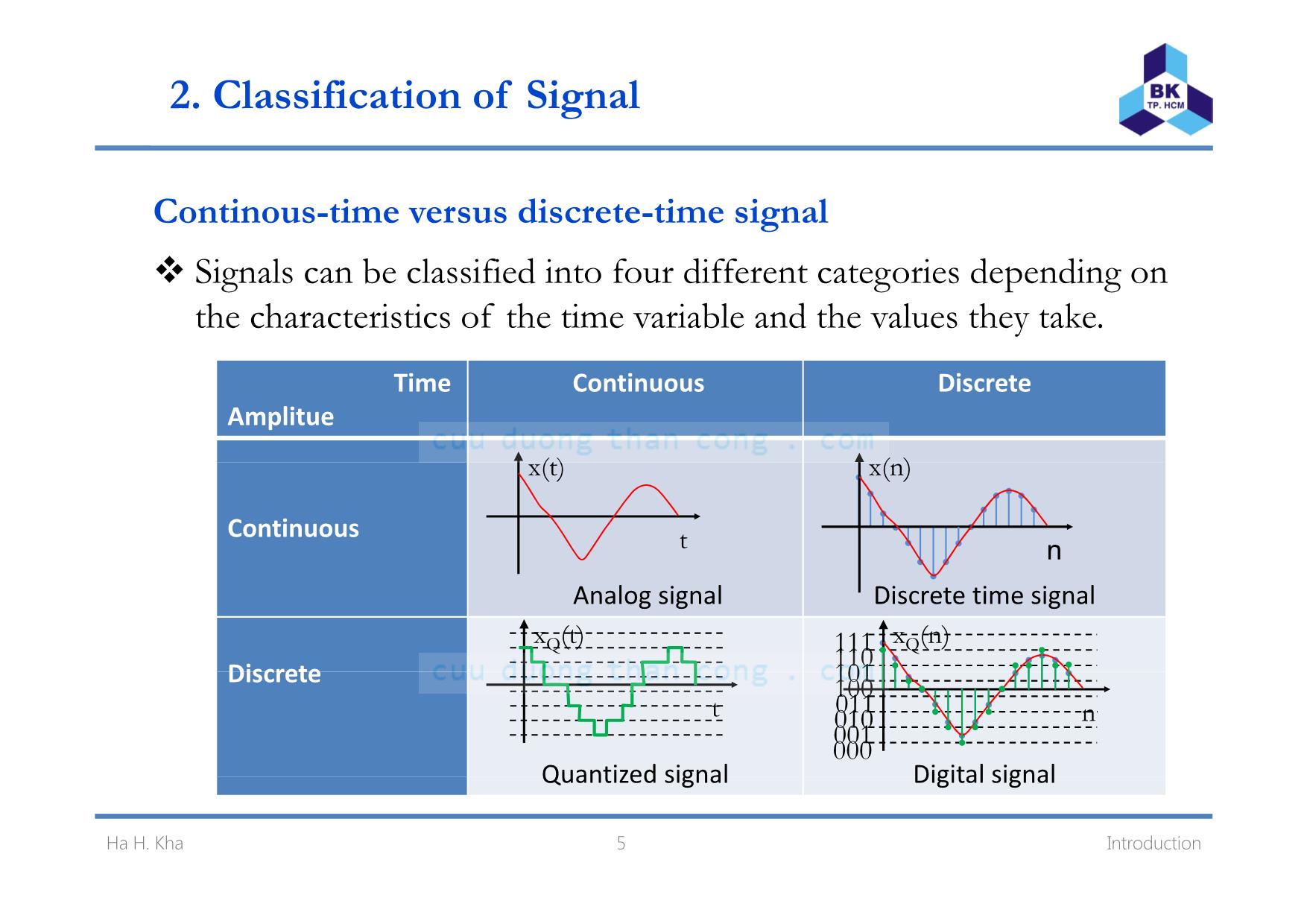
Trang 5
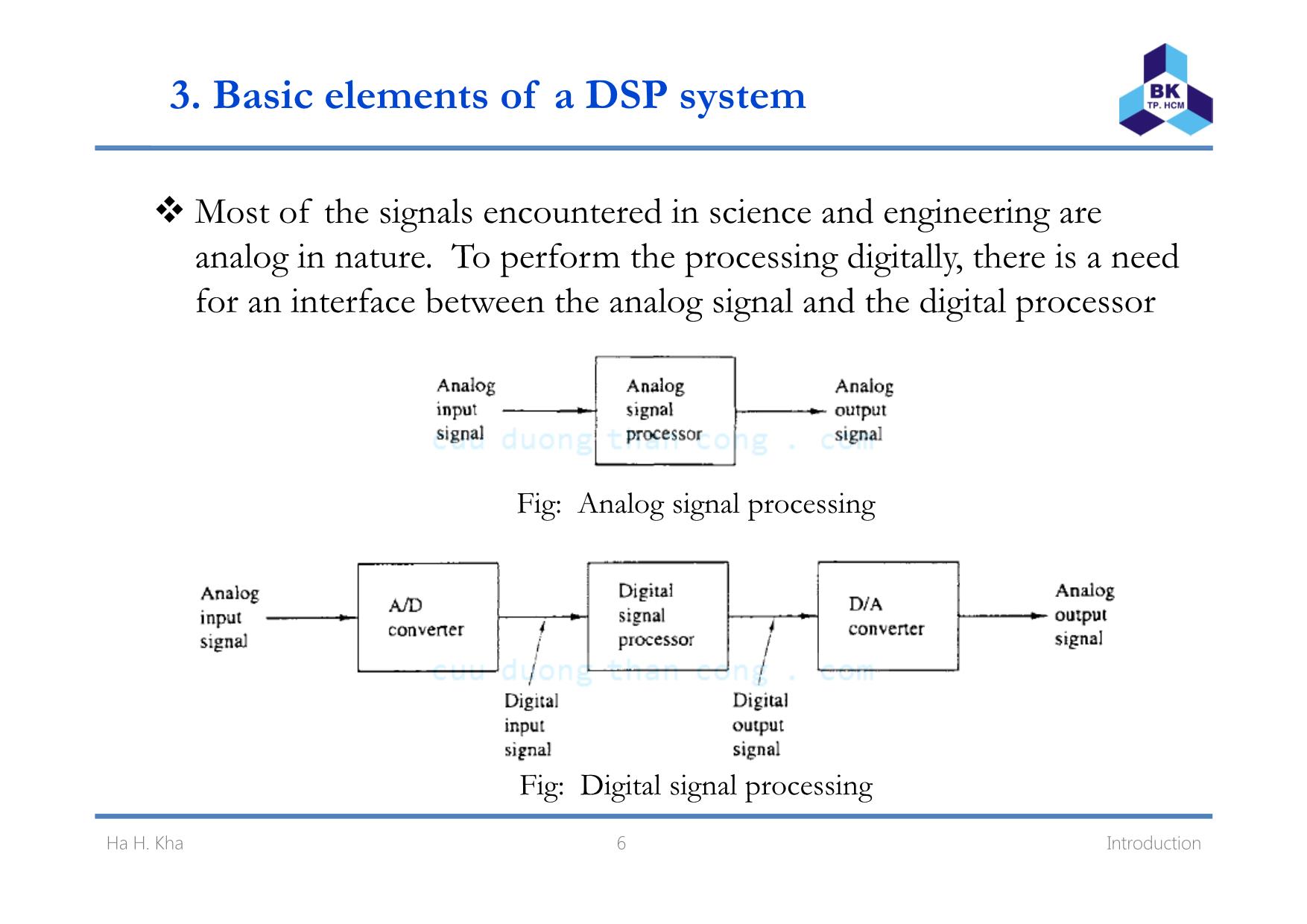
Trang 6
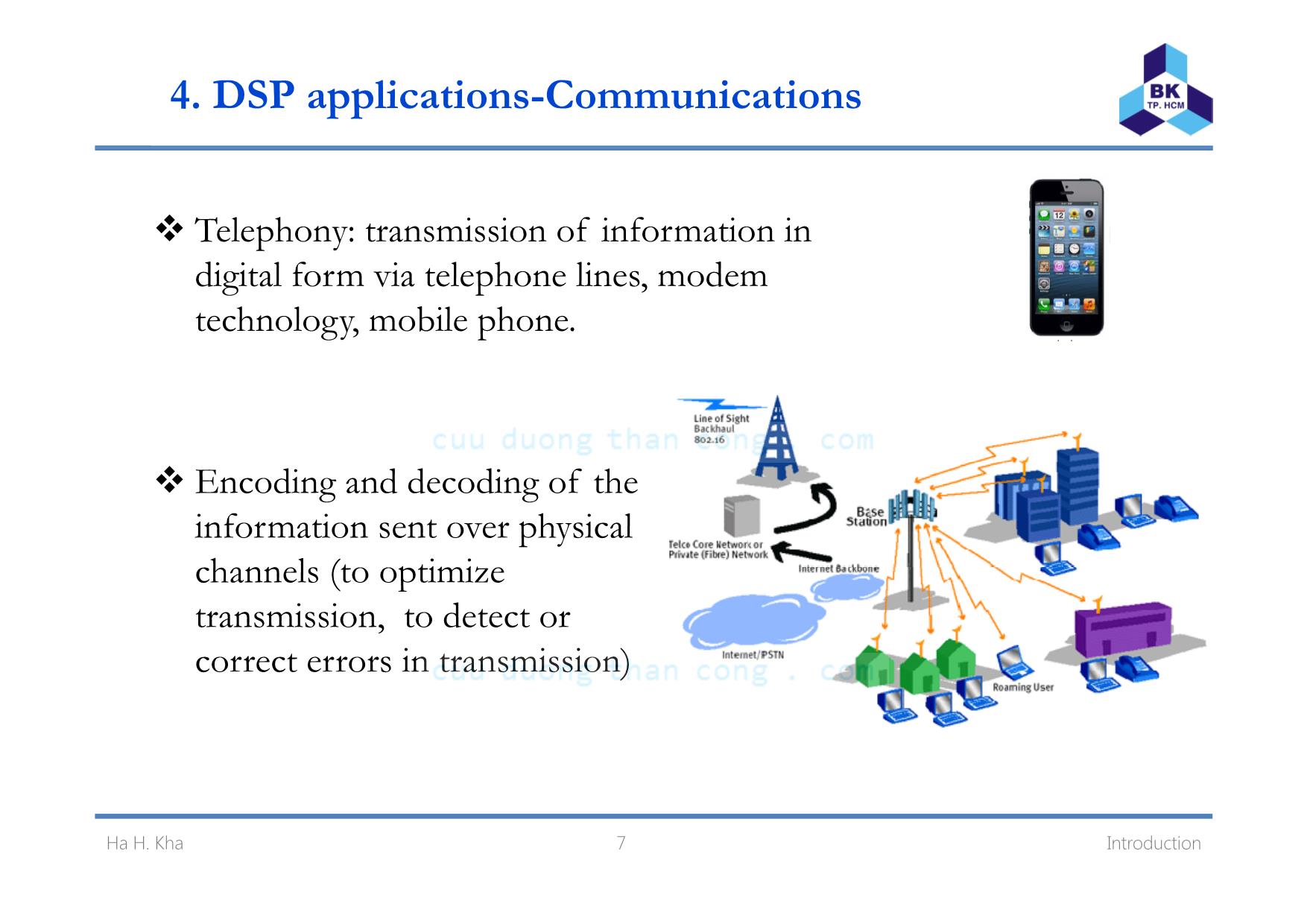
Trang 7
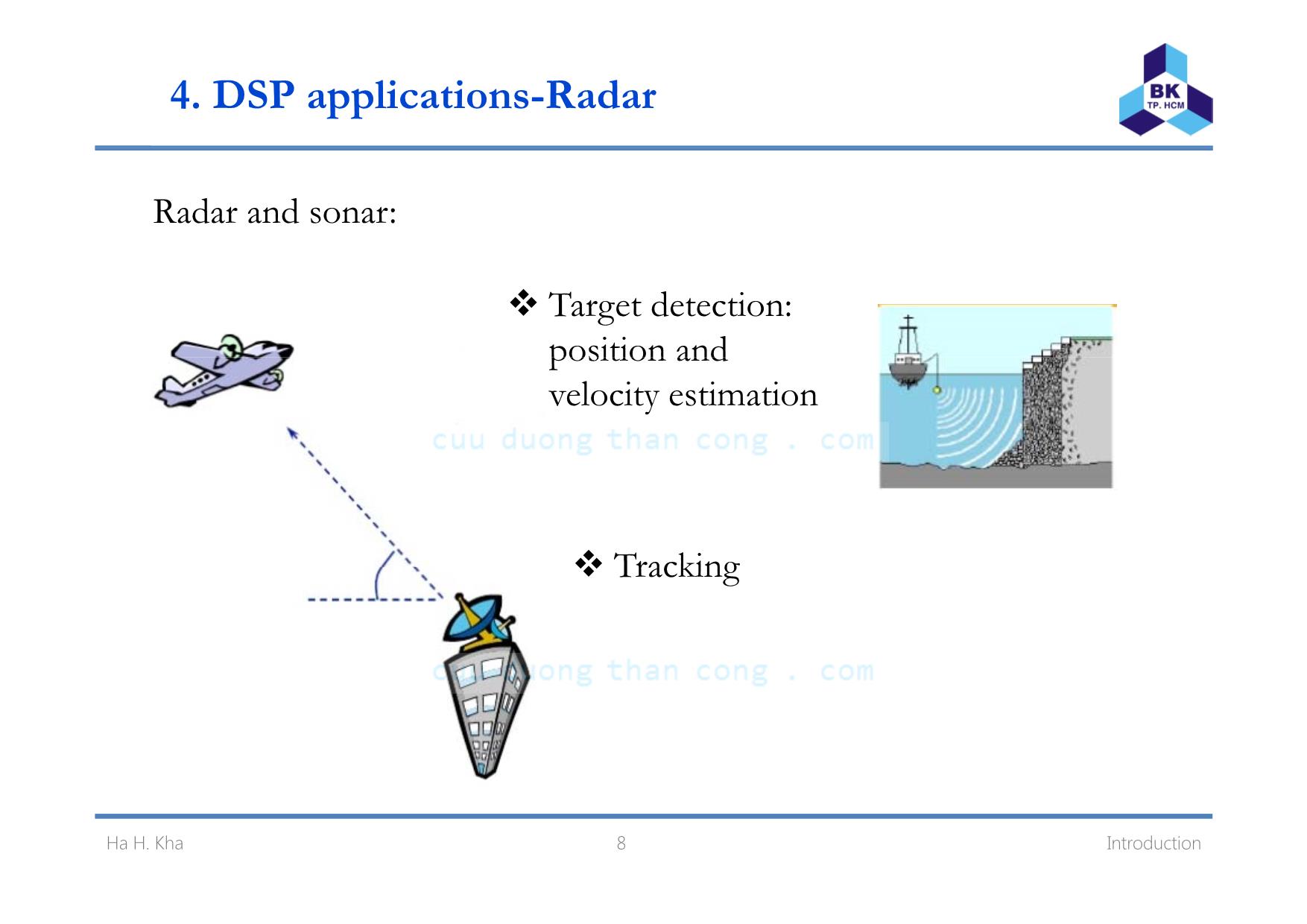
Trang 8
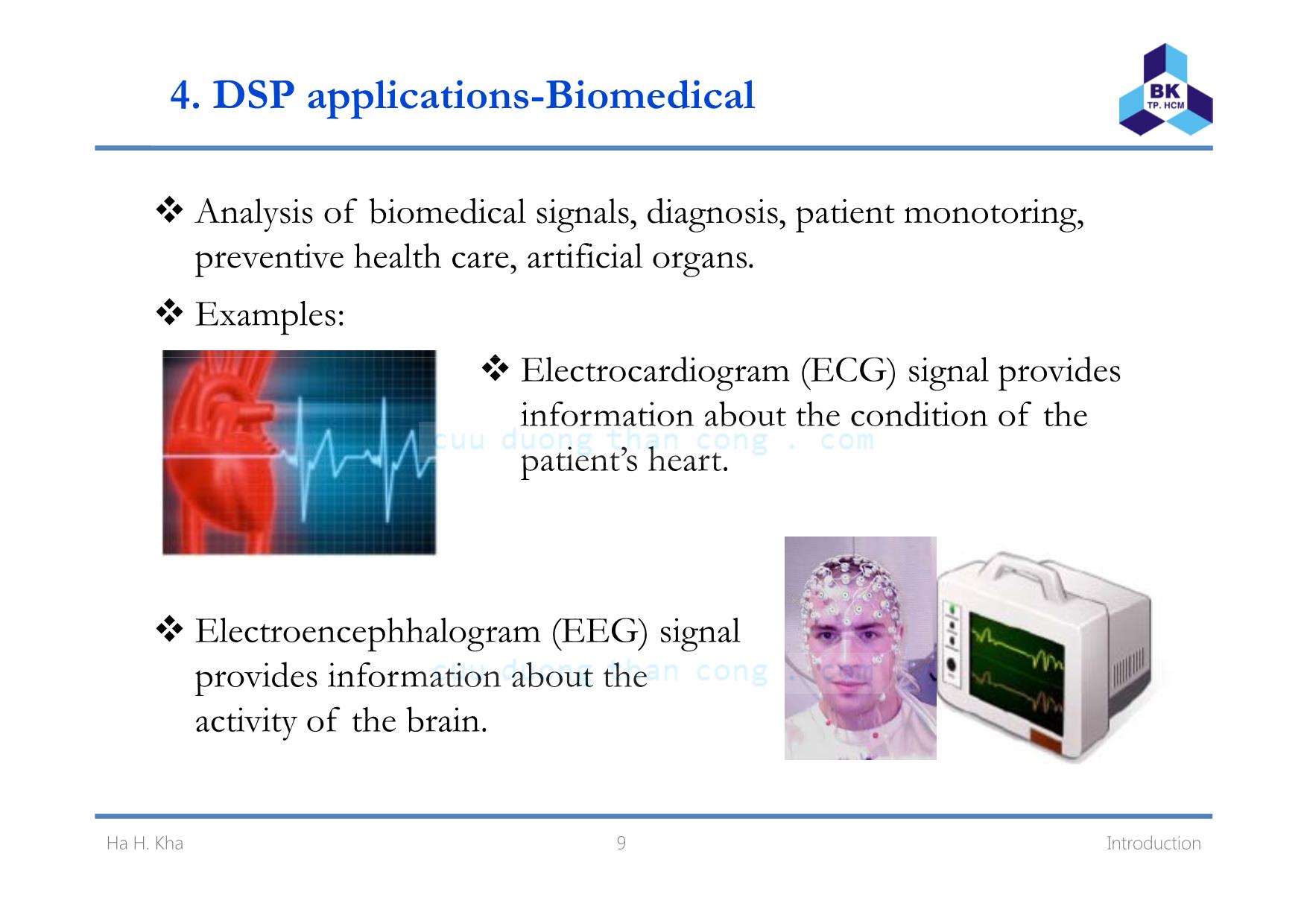
Trang 9
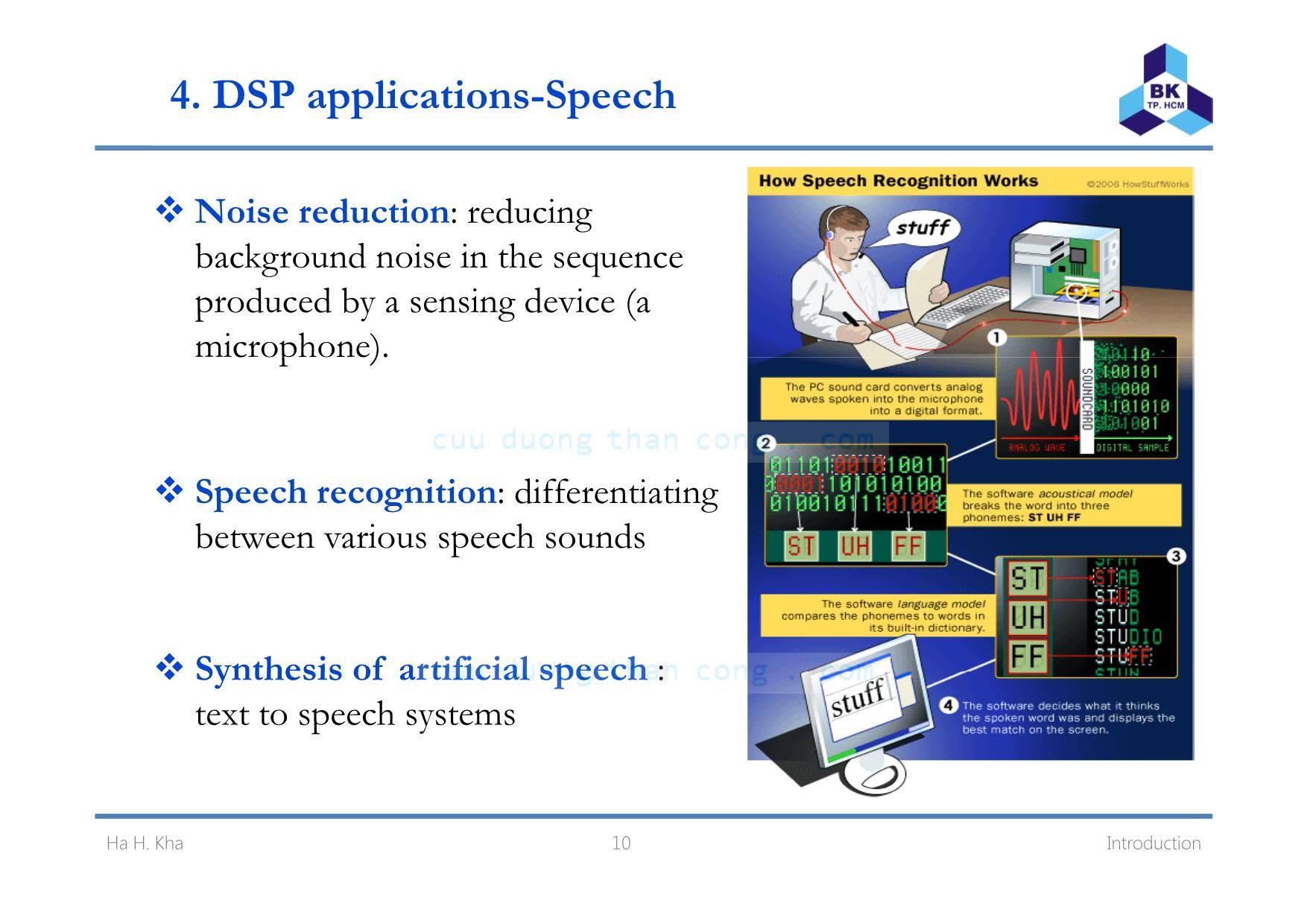
Trang 10
Tải về để xem bản đầy đủ
Bạn đang xem 10 trang mẫu của tài liệu "Bài giảng Xử lý tín hiệu số - Introduction - Hà Hoàng Kha", để tải tài liệu gốc về máy hãy click vào nút Download ở trên
Tóm tắt nội dung tài liệu: Bài giảng Xử lý tín hiệu số - Introduction - Hà Hoàng Kha
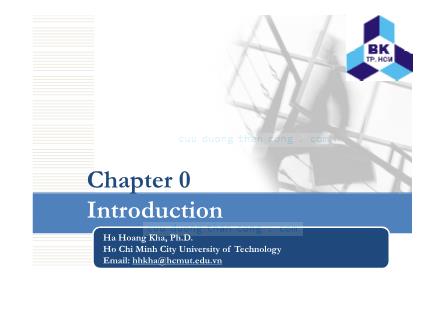
Chapter 0 Introduction Click to edit Master subtitle styleHa Hoang Kha, Ph.D. Ho Chi Minh City University of Technology Email: hhkha@hcmut.edu.vn 1. Signal and Systems A signal is defined as any physical quantity that varies with time, space or an other independent ariables, y v . Speech, image, video and electrocardiogram signals are information-bearing signals. Mathematically, we describe a signal as a function of one or more independent variables. Examples: ( ) 110sin(2 50 )x t tπ= ⋅ 2( , ) 3 2 10I x y x xy y= + + A system is defined as a physical device that performs any operation on a signal. A filter is used to reduce noise and interference corrupting a desired information-bearing signal. 2 IntroductionHa H. Kha 1. Signal and Systems Signal processing is to pass a signal h ht roug a system. A digital system can be implemented as a digital computer or digital hardware (logic circuits). 3 IntroductionHa H. Kha 2. Classification of Signal Multichannels and Multidimensional signals Signals which are generated by multiple sources or multiple sensors can be represented in a vector form. Such a vector of signals is referred to as a m ltichannel signals u Ex: 3-lead and 12-lead electrocardiograms (ECG) are often used in practice, which results in 3-channel and 12-channel signals . A signal is called M-dimensional if its value is a function of M d d bin epen ent varia le Picture: the intensity or brightness I(x,y) at each point is a function of 2 independent variables Color TV picture is 3-dimensional signals I(x,y,t) 4 IntroductionHa H. Kha 2. Classification of Signal Continous-time versus discrete-time signal Signals can be classified into four different categories depending on the characteristics of the time variable and the values they take. Time Amplitue Continuous Discrete (t) ( ) Continuous t x n x n Analog signal Discrete time signal Discrete xQ(n) 101110 111xQ(t) Quantized signal Digital signal n 000001 010011 100 t 5 IntroductionHa H. Kha 3. Basic elements of a DSP system Most of the signals encountered in science and engineering are analog in nat re To perform the processing digitall there is a need u . y, for an interface between the analog signal and the digital processor Fig: Analog signal processing Fi Di i l i l ig: g ta s gna process ng 6 IntroductionHa H. Kha 4. DSP applications-Communications Telephony: transmission of information in digital form via telephone lines, modem technology, mobile phone. Encoding and decoding of the information sent over physical h nn l (t ptimizc a e s o o e transmission, to detect or correct errors in transmission) 7 IntroductionHa H. Kha 4. DSP applications-Radar Radar and sonar: Target detection: position and velocity estimation Tracking 8 IntroductionHa H. Kha 4. DSP applications-Biomedical Analysis of biomedical signals, diagnosis, patient monotoring, pre enti e health care artificial organsv v , . Examples: l di ( CG) i l idE ectrocar ogram E s gna prov es information about the condition of the patient’s heart . Electroencephhalogram (EEG) signal pro ides information abo t thev u activity of the brain. 9 IntroductionHa H. Kha 4. DSP applications-Speech Noise reduction: reducing backgro nd noise in the seq enceu u produced by a sensing device (a microphone). Speech recognition: differentiating between various speech sounds Synthesis of artificial speech : text to speech systems 10 IntroductionHa H. Kha 4. DSP applications-Image Processing Content based image retrieval- bro sing searching and retrie ingw , v images from database. Image enhancement Compression: reducing the redundancy in the image data to optimize transmission/storage 11 IntroductionHa H. Kha 4. DSP applications-Multimedia Generation storage and transmission of so nd still images motion u , , pictures. Digital TV Video conference 12 IntroductionHa H. Kha The Journey “ L i di i l i l i i hi earn ng g ta s gna process ng s not somet ng you accomplish; it’s a journey you take”. R.G. Lyons, Understanding Digital Signal Processing 13 IntroductionHa H. Kha 5. Advantages of digital over analog signal processing A digital programmable system allows flexibility in reconfiguring the DSP operations simply by changing the program. A digital system provides much better control of accuracy requirements. Digital signals are easily stored. DSP methods allow for implementation of more sophisticated signal processing algorithms. Li it ti P ti l li it ti f DSP th ti tim a on: rac ca m a ons o are e quan za on errors and the speed of A/D converters and digital signal processors -> not suitable for analog signals with large bandwidths. 14 IntroductionHa H. Kha Course overview Introduction to Digital Signal Processing (3 periods) Sampling and reconstruction, quantization (6 periods) Analysis of linear time invariant systems (LTI)(3 periods) Finite Impulse Response (FIR) of LTI systems (3 periods) Z-transform and its applications to the analysis of linear systems (6 Mid-term Exam periods) Fourier transform & FFT Algorithm (9 periods) Digital filter realization(3 periods) FIR and IIR filter designs (9 periods) Final Exam 15 IntroductionHa H. Kha References T t b kex oo s: [1] S. J. Orfanidis, Introduction to Signal Processing, Prentice –Hall Publisher 2010. [2] J. Proakis, D. Manolakis, Introduction to Digital Signal Processing, Macmillan Publishing Company, 1989. Reference books: [3] V K Ingle J Proakis Digital Signal Processing Using Matlab . . , . , , Cengage Learning, 3 Edt, 2011. 16 IntroductionHa H. Kha Learning outcomes Understand how to convert the analog to digital signal Have a thorough grasp of signal processing in linear time invariant ‐ systems. Understand the z‐transform and Fourier transforms in analyzing the signal and systems . Be able to design and implement FIR and IIR filters. 17 IntroductionHa H. Kha Assessment Mid‐term exam: 30% Final exam: 70% Bonus: 0.5 mark/solving a problem in the class. 18 IntroductionHa H. Kha
File đính kèm:
 bai_giang_xu_ly_tin_hieu_so_introduction_ha_hoang_kha.pdf
bai_giang_xu_ly_tin_hieu_so_introduction_ha_hoang_kha.pdf

